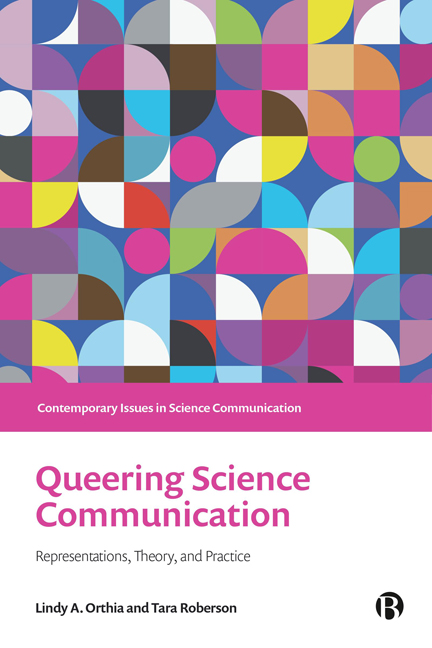Book contents
- Frontmatter
- Contents
- Series Editor Preface
- Notes on Contributors
- Acknowledgements
- Terminology and Sensitive Content in This Book
- Introduction
- PART I Negotiating Queer Identities with Science, Technology, and Medicine
- PART II Representations of Queerness in Public Science Communication
- PART III Queer People in Science Communication Communities
- PART IV Queering Institutional Science Communication Agendas
- Conclusions
- Index
Conclusions
Published online by Cambridge University Press: 18 January 2024
- Frontmatter
- Contents
- Series Editor Preface
- Notes on Contributors
- Acknowledgements
- Terminology and Sensitive Content in This Book
- Introduction
- PART I Negotiating Queer Identities with Science, Technology, and Medicine
- PART II Representations of Queerness in Public Science Communication
- PART III Queer People in Science Communication Communities
- PART IV Queering Institutional Science Communication Agendas
- Conclusions
- Index
Summary
What would it take to queer science communication well? In the first instance, ‘well’ must mean responsible, morally good, and respectful engagement with LGBTIQA+ people and their lives. Queered science communication is about individuals and communities – recognizing their context, the history that informs current and future interactions with areas like STEM, and their needs, which could be met by well-designed science communication. Queer science communication also goes beyond localized cases and asks us to take seriously the question of who and what we represent in wide-spanning, public science communication work, and improving who is bestowed with agency – who speaks and is heard. Queered science communication requires that those with power become uncomfortable, acknowledge the structures and biases that support them, and challenge those structures to make room for others to reclaim the space that is rightfully theirs.
The collection of chapters and spotlights presented in this book represent a first attempt to create an authoritative text on queering science communication. We emphasize first attempt because what it means to queer science communication, to celebrate and explicitly centre LGBTIQA+ people, is still in its earliest stages. We anticipate contributions that build on and contest assertions put forward in this book.
To conclude the book, we here discuss the themes that emerged within it and then what gaps still need to be filled.
Queered science communication is all around
Contributions from our spotlight authors demonstrate that while queered science communication has yet to fully emerge in the research domain, practical queered science communication is starting to flourish in different forums. Drag is increasingly used to communicate scientific topics to broad audiences and platform queer people as described by drag performers Aznar-Alemany and Suciu and colleagues in their spotlights. Queer people are organizing stereotype-debunking events within queer networks, such as the Mardi Gras event detailed by Motion and Sauquet, and injecting queer concerns into science-related art collaborations such as Alifuoco and colleagues’ ‘Endosymbiotic Love Calendar’ and Kaplinsky and Krish's ‘GENDERS’ exhibition. And queer people are self-publishing and networking online via blogs and social media, as we see in Part II's spotlights Using #QueerInSTEM and Queer Science Blogs. LGBTIQA+ people are active in practical science communication.
- Type
- Chapter
- Information
- Queering Science CommunicationRepresentations, Theory, and Practice, pp. 206 - 212Publisher: Bristol University PressPrint publication year: 2023

